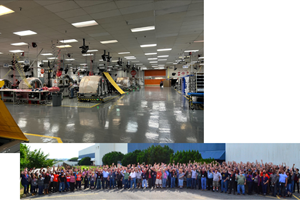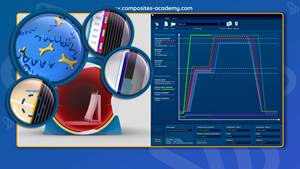Pierce County trains skilled workers through collaborative curriculum building
Bruce Kendall, the president and CEO of the private, nonprofit Economic Development Board (EDB) for Tacoma-Pierce County (Wash.), reports on the success of a collaborative training curriculum development program that produces skilled workersfor the aerospace industry.
Over the years, the economic climate of Pierce County, Wash., has waxed and waned, like that of the rest of the country. It’s no secret that the entire nation has gone through difficult times. We have not been immune. In Pierce County, however, we have taken a proactive approach to emerge from the recession stronger than we were before the downturn. We have made collaboration a priority. And our ability to work together to produce real results from issues we feel passionate about, and our talent in fostering ingenuity and skilled workers, has proven invaluable. Our strategy involved investments in new technologies and industries and also focused on strengthening our traditional bedrock industries.
For nearly 100 years, the aviation industry has been a beacon in the Pacific Northwest. With more than 600 aerospace suppliers, the region boasts more than 90,000 trained workers, and its local leaders strive to grow its workforce via recruitment and training assistance to employers. It’s part of our culture, and the stakes are high. We must recruit manufacturers to the area and ensure that we produce quality workers for them to hire.
In recent years, the state and other entities provided additional workforce training funds in response to our efforts, and there has been an increased need for high-caliber employees as the aviation sector grows and its aging baby-boomer employees retire. We needed to face the problem head on.
Our challenge is not unique. Many regions in the U.S. are ramping up skills-training efforts to close job gaps. However, the way we do that in Tacoma and Pierce County is significantly different. We listen carefully to market demand, and we work with all involved parties in some unique ways.
The result of months of collaboration, the trade skills training in Pierce County is designed not only to get people working, but also to ensure these workers produce what employers really need. Dozens of business leaders, employers, teachers and academic professionals sat down to listen to those who do the hiring and to veteran aviation employees who do the work. These firms also offered their manuals and best practices, lent machines and tools that are actually used on the shop floor, and helped design the classrooms to replicate real work spaces. We then integrated this knowledge directly into the curricula at four area schools.
One thing we kept hearing was the need for better talent. An executive at Tacoma-based General Plastics, for example, said that 60 percent of those hired weren’t making it past 90 days. Because it can take weeks to train in-house, while paying new employees, productivity was lagging. Programs were developed to address the specific challenges at the site, particularly math and other basic job skills.
Fredrickson, in eastern Pierce County, is home to a major Boeing composites manufacturing facility and to Toray Composites America, a global composites supplier. Not surprisingly, we see demand for composites-trained workers increasing steadily. We have taken the initiative to ensure that our schools are prepared to meet the increasing demands for knowledgeable and hirable workers by offering composites-specific courses and certifications. Beyond aviation, composites are used locally in automotive, boatbuilding and other product manufacturing. This is a growing industry, and we plan to capitalize on it.
In Tacoma and Pierce County we have four schools that offer composites-specific training: Clover Park Technical College, Bates Technical College, The Manufacturing Academy and the Pierce County Skills Center (PCSC).
Clover Park Technical College was the first college in the state to provide composites training. Now its curriculum is the basis of the majority of programs offered in Washington and beyond. The Aerospace Composite Technician certification is a two-quarter program designed to prepare students to fabricate, assemble and repair composite materials on aircraft. Clover Park has been selected for three U.S. Department of Labor grants for aerospace and advanced manufacturing, and it has infused more than $1.5 million into these programs to ensure they exceed current industry standards and mirror industry practices. Their work and longstanding relationships with Boeing and other industry leaders have guided their program from development to implementation to job placement.
Bates Technical College offers training and certifications in composites, welding and other areas. There are also 12 Washington state-approved apprenticeship training programs for high schools affiliated with Bates Technical College, including one for the aerospace industry. Apprentices work in the field and earn wages at a percentage of the journey-level rate while they attend classes part-time.
The Manufacturing Academy is the result of a collaborative effort of the Aerospace Joint Apprenticeship Committee (AJAC) and local schools. Its nine-week, 35-credit program (including composites) trains certified workers. It now boasts an 85 percent placement rate. The academy’s workforce training and recruitment programs are designed to prepare workers for manufacturing and aerospace careers. And the students who make it through the academy’s intensive screening process receive free schooling. The students’ eight-hour workdays at the academy mimic those in industry.
The PCSC is entering its third year with a specific focus on composites training. Like the other programs, and working alongside facilities such as the AIM Aerospace composites site in Sumner, Wash., PSCS has replicated in the classroom what students will experience on the factory floor, so high school students can make a seamless and successful transition to a job or postsecondary education. After students complete the program, they understand the importance of lean manufacturing, Six Sigma, demonstrated traceability and accountability, and each has mastered a technical skill in preparation for a high-skill, high-demand job. The PCSC works in conjunction with local community colleges and includes high school students from seven Pierce County school districts. Students now are informed that this is a high-demand industry and that aviation job-placement training opportunities, including composites, are available to juniors and seniors. We encourage kids to be firefighters and doctors. We believe it’s just as important that we inspire students to carry on the region’s tradition of aviation excellence and encourage them to work here, where the jobs are.
Employers, city officials and academic leaders from nine local higher-education institutions have joined together to focus on the aerospace needs of today and tomorrow. And our efforts are paying off. This year, more colleges are mimicking curricula that have been developed in Pierce County.
For more information, visit www.aerospacetacomapierce.com.
Related Content
Reducing accidental separator inclusion in prepreg layup
ST Engineering MRAS discusses the importance of addressing human factors to reduce separator inclusion in bonded structures.
Read MoreAMRC Training Centre introduces composites apprenticeship opportunity
With partners McLaren and Teledyne CML Composites, the Training Center will train new composites technicians in South Yorkshire to build up the future industry workforce.
Read MoreNew online training course targets prepreg basics
JEC World 2024: Composites Expert highlights how its E-Learning Composites Academy platform supports flexible industry learning with new courses developed with Stelia Aerospace North America.
Read MoreADTC to celebrate grand opening for hands-on composites training
The training center’s launch, to include facility tours, demonstrations and networking opportunities, coincides with CAMX in Orlando.
Read MoreRead Next
Ultrasonic welding for in-space manufacturing of CFRTP
Agile Ultrasonics and NASA trial robotic-compatible carbon fiber-reinforced thermoplastic ultrasonic welding technology for space structures.
Read MoreScaling up, optimizing the flax fiber composite camper
Greenlander’s Sherpa RV cab, which is largely constructed from flax fiber/bio-epoxy sandwich panels, nears commercial production readiness and next-generation scale-up.
Read MoreNext-gen fan blades: Hybrid twin RTM, printed sensors, laser shock disassembly
MORPHO project demonstrates blade with 20% faster RTM cure cycle, uses AI-based monitoring for improved maintenance/life cycle management and proves laser shock disassembly for recycling.
Read More








